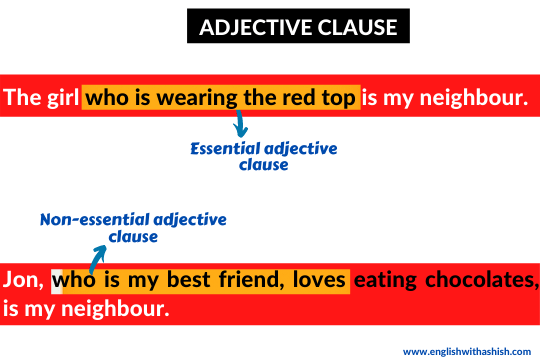
In this post, we learn what an adjective clause is, and how to use it in English. At the end, a video lecture on adjective clauses is attached; you can directly scroll down to it if you prefer videos to articles.
An adjective clause is a type of a dependent clause that works as an adjective. It comes right after the noun or the pronoun it modifies. An adjective clause starts with the following subordinating conjunctions (relative pronouns):

Examples:
“Who lives next to my house” is the adjective clause that’s coming next to the noun ‘guy’ and modifying it.
“That my father gifted me on my last birthday” is the adjective clause that’s sitting next to the noun book and modifying it.
“Which is one of my dream places to visit” is the adjective clause that’s sitting next to the noun ‘Dubai’ and giving information about it. But here, it is giving non-essential information about the noun it’s modifying and that is why it is offset using a comma. ‘Dubai’ is a proper name and doesn’t need any modification to be identified.
There are two types of adjective clauses based on the information they give:
Essential adjective clauses are dependent clauses that modify a noun or a pronoun with essential or defining information. The noun or the pronoun they identify are not proper or specific. An essential adjective clause is important to the meaning of the sentence as it gives essential information about the noun or pronoun it modifies.
Try reading these sentences without the adjective clauses; the sentences will have a completely different meaning without them. That’s why we are calling them essential adjective clauses as they are essential to render the right meaning.
NOTE : Essential adjective clauses are also called defining adjective clauses.
Nonessential adjective clauses are dependent clauses that modify a noun or a pronoun with nonessential or non-defining information. The noun or the pronoun they identify are proper (already identified), and that’s why they are offset using commas.
Nonessential adjective clauses are also called non defining adjective clauses.
(Note that though ‘mangoes’ is a common noun, we are using commas before and after the adjective clause as it just passes a comment on them, not identify them or tell us which mangoes the speaker is talking about.)
Note that these adjective clauses are not essential to the core meaning of a sentence; they are just giving bonus information, which does make a sentence more attractive and meaningful, but they are not giving essential information about the nouns/pronouns they are modifying as they are already identified/specified.
There are 3 components that you need in order to form an adjective clause in English:
These are the 3 things you need, at least, to form an adjective clause in English. Also note that an adjective clause sits right next to a noun or a pronoun, generally a noun, and modifies it with some information.
The cake that she had baked is still there in the fridge.
The relative pronoun (conjunction) sometimes works as the subject of an adjective clause. Look at these examples carefully:
Should adjective clauses be offset using commas or not? That depends on the job your adjective clause does in a sentence: if it gives essential (important) information to identify the noun/pronoun it modifies, don’t use commas to offset it. But if it gives extra information (non-essential) or just passes a comment on the noun or pronoun it modifies, not helping the readers to identify the noun/pronoun it modifies, use commas to offset it.
This sentence has two adjective clauses: the first one “who is one of the best Indian cricketers” is giving extra or non-essential information about the proper noun ‘Virat Kohli’, but the second adjective clause “that will help school students to learn cricket” is modifying the noun ‘academy’ with essential information; it’s helping us understand what type of an academy it’s going to be.
NOTE : ‘Who’ can be used to give essential and nonessential information, and ‘which‘ can’t be used to give essential information.
If a relative pronoun has the subject of the adjective clause, it can be taken out of the adjective clause without changing its meaning.
But if the relative pronoun itself works as the subject of the adjective clause, don’t omit it.
NOTE : relative adverbs (when, where, why) aren’t omitted even if they have their subjects.
‘That‘ can be used in place of ‘who‘ in an adjective clause as that can be used to refer to both a person and a thing.
NOTE : when ‘that‘ is referring to a thing, ‘who‘ can’t be used in place of it. It is only possible when ‘that’ is referring to a person.
Adjective clauses are a type of a dependent clause. It doesn’t give complete meaning on its own. It must be added to an independent clause to render a complete meaning.
Hope you enjoyed the lesson! Feel free to share your question, doubt, or feedback in the comment section, and also, share the post with the people that need it.
For one-on-one classes, contact me at [email protected].